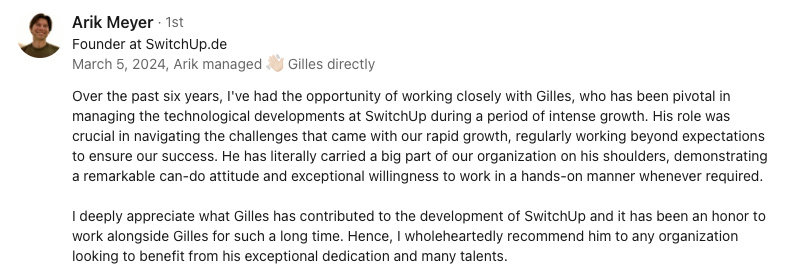Abstract:
As data becomes increasingly vital for businesses, technology executives like CTOs need to understand the complex relationship between data privacy, compliance, and regulations. This involves staying updated on regulations like GDPR and CCPA, ensuring compliance, and promoting a culture of data privacy. Data security is another crucial aspect, involving protection from unauthorized access and educating employees on best practices. Technology executives drive the adoption of security technologies, integrate security into software development, and promote a security-focused culture. Overall, these intertwined aspects of data management, when properly navigated, ensure the protection and integrity of sensitive data, fostering trust with customers and stakeholders.
The importance of data privacy and security for businesses
Data privacy and security have become vital aspects of running a business in the modern age. With every click, tap, and swipe, businesses collect a treasure trove of data that's as valuable as gold but comes with its fair share of risks. Ensuring this data is kept safe and used responsibly involves navigating a maze of regulations and best practices—and who better to lead the charge than the tech wizards at the helm, like CTOs and security officers?
From hefty fines for non-compliance to the potential loss of customer trust, the stakes are high. Data privacy isn't just about keeping sensitive information under lock and key. It involves understanding and adhering to a myriad of rules set by governments and industry bodies, designed to protect consumers and foster trust. Think of it as a complex dance where one misstep could spell disaster, but getting the moves right ensures smooth operations and happy customers.
On the flip side, data security focuses on keeping the bad guys out and the good stuff in. With cyber threats evolving faster than a speeding bullet, today's businesses need to be more like Fort Knox than ever before. Strong firewalls, encryption, and vigilant monitoring are just a few arrows in the quiver of tools needed to fend off potential breaches.
But it’s not all doom and gloom. Navigating these complex waters successfully can transform challenges into opportunities. Businesses that excel in data privacy and security not only protect themselves from threats but also build stronger relationships with their customers. It all boils down to trust—and in this data-driven age, trust can be your biggest asset.
navigating data privacy: compliance and regulations
Keeping up with data privacy regulations in business today can feel like trying to herd cats, but it's absolutely necessary. Key pieces of legislation such as the General Data Protection Regulation (GDPR) and the California Consumer Privacy Act (CCPA) have set the bar high, demanding organizations to adhere to strict data handling and privacy standards. Whether you're a tech giant or a start-up, these regulations apply to you, and staying compliant isn't just about avoiding fines—it's about building and maintaining trust with your customers.
the labyrinth of data privacy legislation
First off, let's talk about GDPR. This regulation, which came into effect in 2018, is a heavyweight contender in data privacy law. It has far-reaching implications for any business handling the personal data of EU citizens. That’s right, even if your company is headquartered in Timbuktu, if you process data for Europeans, GDPR has you in its sights. The regulation mandates that organizations must ensure personal data is processed lawfully, transparently, and for a specific purpose. If not, they risk facing hefty fines up to 4% of their annual global turnover or €20 million (whichever is higher). Yikes!
On the other side of the pond, we have the CCPA, which came into effect in 2020. This regulation grants California residents new rights concerning their personal data, including the right to know what personal data is being collected, the right to delete their data, and the right to opt out of the sale of their personal data. Think of it as GDPR with a West Coast twist. Both sets of regulations emphasize consumer rights and data protection, making it vital for businesses to stay ahead of the curve.
keeping up with evolving regulations
One of the biggest challenges for technology leaders is staying updated with these evolving regulations. They can change more frequently than the weather, and missing a single update could mean non-compliance. So, how can businesses manage this? The answer lies in continuous education and vigilance. Regularly training your team on data privacy best practices and keeping an eye on legal developments is crucial. Additionally, having a dedicated data protection officer (DPO) can be a game-changer. A DPO ensures that your company’s data handling processes are ironclad, policies are updated, and everyone is on the same page.
fostering a culture of data privacy
Compliance isn’t just about ticking boxes; it's about fostering a culture where data privacy is ingrained in the company’s DNA. Leaders should actively promote the importance of data privacy from the top down. Here are some strategies to consider:
- Education and Training: Regular workshops and training sessions ensure that employees are aware of the latest data privacy regulations and best practices. Knowledge is power, after all.
- Clear Policies and Procedures: Develop comprehensive policies that outline how data should be handled, stored, and protected. Make these policies easily accessible to all employees.
- Data Minimization: Collect only the data you need. The less data you have, the less you must protect, and the lower the risk of mishandling.
- Regular Audits: Conduct regular audits and assessments to ensure compliance. These audits can identify potential weak spots before they become actual problems.
- Transparency: Be clear with customers about what data you collect, why you collect it, and how it will be used. Transparency helps in building trust and demonstrates your commitment to data privacy.
safeguarding data: it's more than just a tick-box exercise
Finally, safeguarding data is about more than just meeting regulatory requirements—it's about protecting your customers and your business. Investing in robust cybersecurity measures, such as encryption and multi-factor authentication, goes hand-in-hand with compliance efforts. Business leaders should never view regulatory compliance as a one-time project; it’s an ongoing commitment.
In a nutshell, while navigating the tightrope of data privacy regulations can be complex, it’s an essential part of modern business. With the right strategies and a proactive approach, businesses can not only achieve compliance but also enhance their reputation, foster customer trust, and ultimately, boost their bottom line. Now, who wouldn’t want that?
ensuring data security: protection and best practices
While data privacy regulations ensure that companies handle their data responsibly, data security focuses on building systems to prevent unauthorized access. It's like setting up an impenetrable fortress around your castle of precious data. Let's break down how executives can drive the adoption of advanced security technologies, embed security into the software development process, and foster a culture of vigilance.
advanced security technologies: your new best friends
Imagine your data as the crown jewels. You wouldn’t just lock them in a wooden chest; you’d deploy cutting-edge security measures to fend off would-be thieves. This is where technologies like encryption, firewalls, and intrusion detection systems come into play. But the tech landscape is always evolving, so staying ahead means investing in the latest innovations.
Advanced security measures could include:
- Encryption: Imagine giving your data a secret identity. Encryption transforms readable data into an encoded format that can only be deciphered with a key. This keeps unauthorized parties from accessing sensitive information.
- Multi-factor Authentication (MFA): A world where passwords alone aren’t safe. MFA requires users to provide two or more verification factors to access resources, adding an extra layer of protection.
- Artificial Intelligence (AI) and Machine Learning (ML): These tech marvels can identify and respond to threats faster than a speeding bullet by analyzing traffic patterns and detecting anomalies.
- Next-Gen Firewalls: These aren’t your grandfather’s firewalls. They offer features like application awareness and control, integrated intrusion prevention, and advanced threat protection, making them a formidable barrier against unauthorized access.
By backing these technologies, executives aren’t just protecting the data—they’re taking proactive steps to anticipate and mitigate future threats.
integrating security into the software development lifecycle
Security isn't something you slap on top of your software like icing on a cake. To be effective, it needs to be baked into your development process from the get-go. This is known as integrating security into the Software Development Lifecycle (SDLC).
Steps to do this include:
- Security by Design: This means considering security aspects from the initial design phase. Developers should identify potential security risks early and implement safeguards to mitigate them.
- Secure Coding Practices: Encourage developers to adopt secure coding standards. This reduces vulnerabilities that cyber-attackers could exploit.
- Automated Security Testing: Employ automated tools to continuously scan code for vulnerabilities. This continuous checking helps catch potential issues before they become big problems.
- Regular Security Reviews: Conduct regular reviews and audits of the codebase to identify new security concerns and ensure ongoing compliance with security standards.
Executives play a pivotal role by championing these security practices, ensuring the development teams receive adequate resources and training.
creating a security-focused culture
Data security isn't just an IT department issue; it's a company-wide responsibility. Creating a culture where security is everyone's job is key, and leadership must set the tone.
Here’s how to foster a security-focused culture:
- Regular Training: Offer frequent training sessions that inform employees about the latest security threats and best practices. Knowledge is the best defense.
- Clear Communication: Make sure that security policies are clearly communicated and understood across the organization. Everyone should know what is expected of them.
- Encourage Reporting: Create a safe environment where employees feel comfortable reporting suspicious activities or potential security breaches without fear of ridicule or retribution.
- Lead by Example: Leadership should model good security behavior, from using MFA to reporting phishing emails. When higher-ups take security seriously, so will everyone else.
- Collaborative Environment: Facilitate regular meetings and workshops where departments can share their security challenges and solutions, fostering a sense of joint responsibility and teamwork.
The goal is to make security second nature to everyone in the company. Much like brushing your teeth, it should be a daily routine rather than a sporadic effort.
importance of employee education
Even with the best technology and processes in place, human error can still derail security efforts. This is why educating employees on security best practices is crucial.
Strategies for employee education might include:
- Phishing Simulations: Regularly conduct controlled phishing simulations to test employees’ ability to recognize and respond to phishing attempts.
- Interactive Workshops: Create engaging, hands-on workshops where employees can learn about security threats in a practical setting.
- Real-World Examples: Share real-world examples of security breaches to illustrate the consequences of lapses and underscore the importance of vigilance.
- Consistent Reminders: Use newsletters, posters, and intranet announcements to consistently remind employees of security best practices and emerging threats.
By empowering employees with the knowledge and tools they need, businesses can create a comprehensive defense strategy that leaves no weak links.
In conclusion, securing data is not just a technical challenge; it's a holistic endeavor that requires involvement from everyone in the organization. From advanced security technologies to embedding security in development and fostering a culture of vigilance, it's all interconnected. And remember, while the trail to robust security might be winding, the view from the top is worth the effort!
conclusion and key takeaways
Technology executives hold the compass, steering through the complicated ocean of data privacy and security. They've got to balance the tightrope walk between compliance with evolving regulations and ensuring robust protection against cyber threats. This dual responsibility is no small feat, but it is crucial for maintaining the integrity of sensitive data and fostering trust with customers and stakeholders alike.
Here are some key takeaways to remember:
- Compliance is non-negotiable: Adhering to regulations like GDPR and CCPA isn't just good practice; it’s essential for avoiding fines and building consumer trust.
- Education is fundamental: Regular training sessions about data privacy and security can arm employees with the knowledge needed to act responsibly and spot potential threats.
- Advanced security technologies are vital: Embracing tools like encryption, multi-factor authentication, and advanced firewalls helps protect valuable data assets.
- Security should be integrated into development: Building security into every stage of the software development lifecycle ensures that products are robust from the ground up.
- A security-focused culture is everyone's job: When security becomes ingrained in your company culture, you create a stronger, more united defense against threats.
Ultimately, mastering the art of navigating data privacy and security can transform potential challenges into a competitive advantage. So, tech leaders, keep those digital fortresses strong and stay vigilant—because your data’s worth its weight in gold!
You might be interested by these articles:
See also:
- Gilles Crofils: Skills, Industries and Markets
- Leading with Heart in the New Era
- Unveiling the Power of Info in Tech Evolution
- Next-Gen Electric Vehicle Charging Infrastructure
- AI transforms wind energy maintenance with predictive insights
- Bridging Gaps with Digital Learning
- Satellite communications: boosting data security for startups





